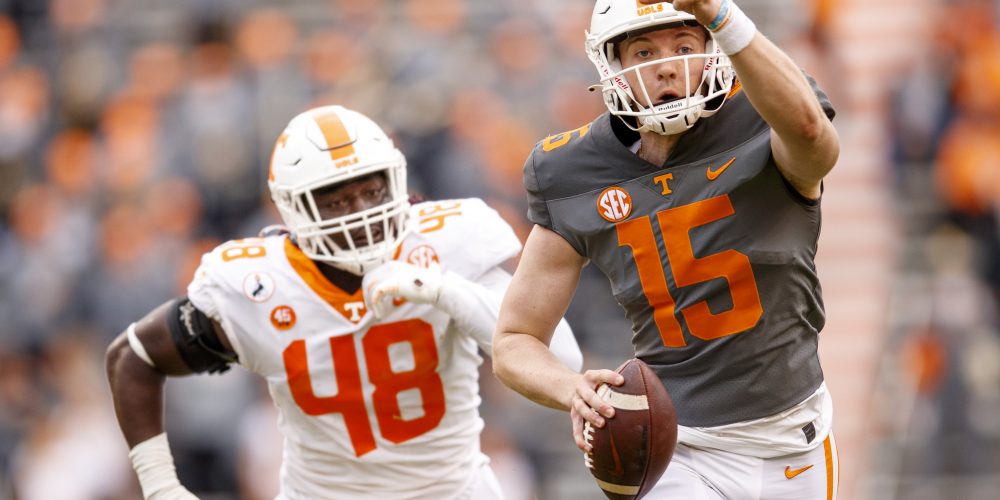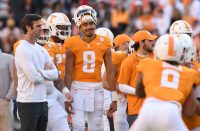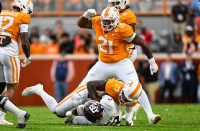When Tennessee went 1-for-11 on third down in the season opener but beat South Carolina anyway, we laughed it off. Fun anomaly! Let’s move on! And the Vols did, going 6-of-13 against Missouri the following week.
As you’ll recall, not much else went right from there. And as far as Tennessee’s offense was concerned, the opening performance at South Carolina was a red flag after all. In 2020, the Vol offense went 39-of-129 (30.23%) on third down, 119th in college football. It was the thing Tennessee’s offense was worst at.
There’s little differentiation between run, pass, short yardage, and long yardage. The Vols simply struggled everywhere on third down last season.
In the past, this kind of extreme struggle on third down was usually attributed to a quarterback injury. In the post-Fulmer era, the Vols have converted on less than 35% of their third down attempts in conference play four times in 12 years (stats via SportSource Analytics). Two of those came in 2011 and 2013. When Tyler Bray got hurt against Georgia and Derek Dooley burned Justin Worley’s redshirt two games later, the Vols went 2-of-14 against Alabama, 2-of-14 against South Carolina, and 4-of-18 at Arkansas. Two years later when it was Worley who went down with injury, Josh Dobbs was thrown to the fire and went 3-of-12 against Alabama, 2-of-13 at Missouri, and 4-of-13 against both Auburn and Vanderbilt. In both of those cases, playing great opponents (and maybe James Franklin’s best Vanderbilt team) were a big part of the problem.
In 2017, the offense showed signs of third down life early even as the defense was decimated by Georgia Tech: 5-of-12 against the Yellow Jackets, 7-of-13 against Indiana State, 6-of-16 at Florida, 7-of-18 against UMass. We all know how this year ended; the problem here wasn’t converting on third downs, but needing 18 of them against UMass. Still, the Vols were 25-of-59 (42.4%) on third down going into the Georgia game. From there, disaster: 1-of-12 against the Dawgs, 3-of-13 against South Carolina, 1-of-12 again at Bama, plus an agonizing 2-of-13 against Southern Miss. Absolutely nothing worked for this team or its offense in the second half of the year.
But last year the Vols were quite bad throughout, with the exception of Missouri early and Auburn (9-of-15) late. Take a look at the rest of the damage:
| Opponent | Cnv | Att | Pct. |
| South Carolina | 1 | 11 | 9.09% |
| Missouri | 6 | 13 | 46.15% |
| at Georgia | 4 | 17 | 23.53% |
| Kentucky | 3 | 12 | 25% |
| Alabama | 4 | 16 | 25% |
| at Arkansas | 5 | 15 | 33% |
| at Auburn | 9 | 15 | 60% |
| Florida | 4 | 15 | 26.67% |
| at Vanderbilt | 2 | 9 | 22.22% |
| Texas A&M | 1 | 6 | 16.67% |
Gross.
(One interesting note I found that I’m not sure where to put: Harrison Bailey on first down last year went 24-of-26 for 345 yards (13.3 ypa) and three touchdowns. He had the second highest QB rating on first down in the nation.)
In good news: Central Florida has been pretty good at this.
UCF finished 11th nationally last fall at 48.75%, 61st in 2019 at 40.5%, and fifth in 2018 at 50.29%. They’ve won with and without high third down conversion rates, which probably speaks more to their defense than anything else, especially last season. But the idea that Josh Heupel’s offense is big plays or three-and-outs only isn’t the case: this group has been really efficient on third downs.
Also of note: Missouri finished 20th nationally in third down conversions in 2017, and 42nd in 2016. Heupel’s first Tigers struggled in October – 4-of-14 at LSU, 4-of-15 at Florida, 4-of-15 against Kentucky – but had it rolling by November, as Tennessee’s 2016 defense will attest to (11-of-20 against the Vols).
The best way to avoid struggling on third down remains, of course, to avoid struggling on first and second down. In this way, Heupel’s offense is also more than simply big plays: 30% of UCF’s third downs last year required only 1-3 yards to gain for the first down. For the Vols, only 26.5% of their third downs required 1-3 yards to gain, the same number of snaps they took requiring 4-6 yards to gain. One additional note here: Central Florida actually had a higher percentage of 3rd-and-10+ than the Vols did last year (23.75% to 22.8%) despite having a much better offense overall; my assumption here is they were far more likely to throw two incomplete passes on first and second down and face a 3rd-and-10.
For Tennessee, again, it can’t really get worse. But I’m curious to see how much efficiency shows up with this offense in year one, on top of the explosiveness we all know is out there. Will the Vols find themselves in a ton of 3rd-and-10s? Or will this new offense find its way to more success not just through trying to hit home runs, but giving themselves to advance on third-and-manageable?
More in the Making Progress series:





After we hired Huepel, I went and watched a lot of UCF while he was there. I can verify that they absolutely didn’t mind taking shots down the field on 1st and 2nd down which did lead to some long 3rd downs. I think their mindset was, “We’ve got 3 tries to make a 10+ yard play. We can get a 1 out of 3 ratio of successful plays.” The thing is, they were generally correct.
They were 55% run/45% pass on first down last year, but 15% of their first down completions went for 25+ yards. It’s a good balance on paper, I’m curious to see how they feel about it if the QB situation is less certain.